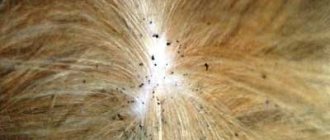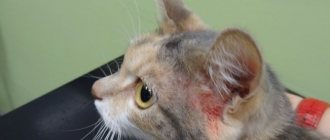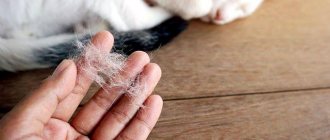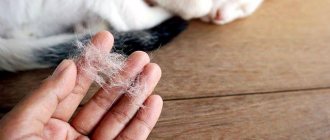Very often you can hear complaints from owners of purring pets that the cat is constantly itching and licking and how to treat the animal in this case. It should be understood that itching is just an external sign that may indicate some kind of disease.
If a cat licks itself, combs itself immediately after waking up or after eating, this is quite normal, this is how it takes care of itself, puts its fur in order, wiping its eyes and ears.
However, if a cat itches almost incessantly, worries, and feverishly licks itself, this is a reason to consult a doctor, since active skin itching may indicate a pet illness or the presence of not fleas, but other parasitic microorganisms on the animal’s body.
Itching may be a signal that this is how cat skin diseases manifest themselves.
The cat is constantly itching: type of itching and diagnosis
If, when a breeder visits a veterinary clinic with a complaint that the cat is itching a lot, the specialist immediately prescribes flea treatment without establishing the presence of parasites, you should change the clinic. The rules of the RosVet VC state that the first thing people pay attention to is the type of itching:
- the cat licks and scratches;
- gnaws the body (paws);
- against the background of scratching, he has extensive bald patches (alopecia on the stomach and thighs).
In the future, the doctor follows the standard algorithm for diagnosing pathologies that are accompanied by scratching. A detailed analysis allows us to determine the cause:
- medical history (duration of itching, type of feeding and type of feed, presence/absence of antiparasitic treatment, possibility of allergies);
- analysis of itching (strength, frequency, duration, localization);
- exclusion of fleas, ticks (inspection, scrapings);
- microscopy of scratching sites (scrapings are examined under a microscope).
Externally, the auricle and ear canal are examined for otitis media and marginal seborrhea. They do a feed test (FCA), observe it, and apply an elimination diet. Atopic allergies or obsessive-compulsive disorders (stress, neurosis) are excluded.
It is important to know! There should be a history of previous antipruritic therapy. The breeder explains in detail what they used at home, whether or not they visited another clinic, and what medications were used.
If the cause is identified, the underlying disease is treated. It is not recommended to use drugs against exoparasites “at random”; the symptoms can be smoothed out or distorted and the diagnosis will be made incorrectly.
Special diet
During treatment, dietary products are selected for the cat, the consumption of which reduces the intensity of itching and the likelihood of relapses. Your cat's daily diet should be balanced. It is not recommended to give smoked and sweet foods.
Adviсe:
- If the cat was eating food before the allergy appeared, then purchase a hypoallergenic variety.
- When a cat is fed regular food, pork, potatoes and porridge are removed from the diet. They give fish, butter and vegetables.
- Adding fish oil to food (tuna, salmon, sardines, anchovy) helps reduce itching.
Timely adjustment of the diet and daily monitoring of the animal’s condition are required.
Why does a cat itch: reasons
There are at least 2 dozen causes of scratching, each has its own specific differences and, in addition to severe itching, is accompanied by a host of symptoms that the breeder must notice. It would be correct if, when collecting an anamnesis, he talks in detail about the nature of the scratch, so the veterinary dermatologist will quickly and accurately diagnose and prescribe treatment.
Sarcoptic mange
Subcutaneous and cutaneous parasites, with them the cat itches, dandruff on the body, crusts:
- otodecosis (itching on the face, ears, back of the head, oily dark deposits in the ears);
- sarcoptic mange (unbearable itching to wounds, localized on the neck, chin, muzzle, body along the ridge, tail root, formation of scabs, hair loss);
- notoedrosis (itching in the area of the brow ridges, the back of the head, on the face, the cat scratches itself until it bleeds, the skin darkens and becomes very thick, folds appear);
- cheyletiellosis (the trigger of itching is a small skin mite located along the ridge and at the root of the tail; the cat is always itching. Visually, through a magnifying glass, you can detect a gray mass of “dandruff” - this is the mite moving, it can move throughout the body).
Cutaneous parasites feeding on the host's blood can be noticed independently or when examining pathological material under a microscope. These are lice, fleas, lice eaters. A distinctive feature is the suddenness of the scratch; the cat literally attacks the bite site, itches and licks. In places of intense scratching, alopecia forms, you can find a cluster of black dots - nits, flea dermatitis is characterized by multiple red dots-rash.
According to observations, up to 90% of cases of itching occur due to flea bites and an allergic reaction in a cat to insect saliva.
Allergy
A cat can develop an allergic skin reaction with itching to anything. More often these are industrial feeds, shampoos, saliva of blood-sucking insects, dust, home fragrances, etc.
If you are allergic to food, the animal scratches its head, groin, or belly. When the allergen is exposed to contact, scratching at the site of the allergen localization. Flea dermatitis is located along the spine, at the root of the tail and on the outer surface of the thighs. If you are allergic to chemicals or perfume, your eyes and nostrils are affected (+ sneezing, drooling).
Bacterial and fungal infection
Fungi and bacteria can become active on the skin, but more often this happens as an addition to the primary infection or a decrease in immunity. The picture of itching will be different, these are weeping and itchy ulcers, eczema. At the same time, the cat constantly licks them, which provokes the formation of large, open wounds, which are then very difficult to stitch.
With dermatophytosis, the cat itches intensely, foci of alopecia and peeling appear, and a dense, reddish border (ringworm) forms around the site of the lesion.
Dermatitis
A collective concept, a general designation for skin lesions. This includes parasitic pathologies, allergies, neurological diseases, etc. It is considered a symptom in a symptom complex and is not considered as an independent disease. There is always: itching, redness, swelling, peeling, swelling of the skin. An increase in local temperature is often associated.
Increased dry skin
Another condition is called dry seborrhea or xerosis. It develops when there is a critical deficiency of vitamins E and A in the feed or due to improper use/selection of shampoos. The epidermis dries out, itches severely, and cracks.
At the beginning, the breeder only notices itching, the cat is worried, scratches its back, sides and ribs, and may gnaw its paws in the joint area. Then dandruff appears, cracks turn into open wounds. Wool loses its shine and elasticity.
Internal causes of itching in cats
The most difficult to detect and treat are autoimmune pathologies in which the cat itches. The essence of the problem is a violation of the immune system, when one’s own protective cells begin to perceive the tissues and cells of the epidermis as foreign. They attack them, trying to destroy them.
In the list of pathologies:
- discoid lupus erythematosus. The disease is more common in dogs and is characterized by the sudden appearance of sores on the skin. Conventional antimicrobial therapy does not produce results. The best results are observed with the use of glucocorticoids and immunosuppressants;
- pemphigus foliaceus. The cat scratches its face, especially the bridge of its nose and upper lip. Inflammations, ichor, and crusts appear at this site;
- Jacobs ulcer. This is a “personal” disease of cats, its manifestations are similar to herpes in humans. Spots form on the upper lip, turning into blisters and ulcers. The more advanced the process, the more tissue is affected, up to the exposure of gums and teeth. Wound healing therapy and antibacterial agents are powerless.
The list of neurogenic causes of severe itching in cats includes neurodermatitis and neoplasms (tumors). With neurodermatitis, the pet scratches its head, neck, and ears a lot. Then the pathological process moves to the groin, stomach, back, front legs. In advanced cases, the cat simply chews off its paws due to unbearable itching, and extensive ulcers form throughout the body. Neurodermatitis is transmitted genetically, so animals with this diagnosis are sterilized (neutered).
Tumors, especially malignant ones, can be found throughout the body and attract the cat with mild itching. Scratching only worsens the course of cancer.
Bacterial or fungal inflammation
Various opportunistic microorganisms living on your pet's skin do not harm a healthy animal. But if your cat’s body has been weakened, for example, due to some disease or lack of vitamins, then the population of “harmful” fungi and bacteria increases, causing the cat’s skin condition and general well-being to deteriorate.
The doctor will check for inflammation caused by fungus or bacteria and also conduct a smear examination. As a rule, this inflammation is not the main cause of the disease.
Possible causes of itching
If a cat is constantly itching during examination at the RosVet EC, the following must be excluded/confirmed:
- inflammation of the paraanal glands;
- helminths;
- kidney disease, liver disease and changes in the functioning of the endocrine system;
- otitis;
- marginal seborrhea of the auricles;
- hormonal disorders.
It is important to know! Cats are very susceptible to stress. Behind external equanimity lies a subtle and vulnerable soul, and any psychological discomfort can result in the development of psychogenic itching. OCRD (OCD) is considered an exclusionary diagnosis; behavioral obsessive-compulsive disorder is expressed in the constant habit of scratching and biting oneself. This is a psychological dependence on the process itself, from boredom, the paws and tail suffer (it gets chewed off).
Owner actions: diagnosis and treatment
Without fail, as soon as the breeder notices that the domestic cat is itching, the animal must be taken for examination to the RosVet VC to a veterinary dermatologist. In the clinic:
- check the ears and face;
- microscopy of scrapings and trichoscopy will be performed;
- carry out bacterial and fungal cultures;
- They will do histology and cytology of the problem area.
Without fail, if there is a suspicion of an allergy from food, an “elimination diet” is prescribed. This means that “old” ingredients will be gradually removed from the diet and replaced with new ones. As soon as the allergy passes, the allergen is found. But this is a very long process, sometimes lasting months.
Species-specific allergy tests are rarely carried out in cats due to their high cost and low information content.
Treatment for itching in cats
It is impossible to treat a cat with anti-flea agents, use antibacterial ointments or any medications without a veterinarian’s prescription. It is important to first make an accurate diagnosis, then use medications. Otherwise, the true clinical picture will be blurred, the disease will progress and the general condition of the pet will worsen.
Treatment happens:
- etiotropic (that is, they act directly on the provoking factor of itching, the cause);
- symptomatic (eliminate directly).
The list of prescriptions may include antihistamines, atopic, glucocorticosteroids, pentoxifylline, Omega-3, and psychotropic drugs.
If your cat is itching, do not rush to treat it for fleas. The causes of itching are numerous and incorrect use of remedies will not help the animal, but will only increase its suffering. Call the RosVet VC by phone, 24 hours a day. Make an appointment for your cat to see a veterinary dermatologist.
Fighting methods
Flea bites are very painful. They cause a lot of suffering to the animal. Their consequences can be very serious. These are all kinds of skin inflammations, dermatitis, furunculosis. In addition, insects can be carriers of serious viral diseases. How to get rid of fleas, these insatiable parasites? To do this, you will have to arm yourself with patience, since it is necessary to treat not only the animal, but also the room where it lives.
Animal processing
So, how do you get rid of fleas in cats? Treatment can be carried out using insecticidal or repellent agents. Currently, there are a huge number of various chemical preparations that are highly effective against this type of parasite. The most popular of them are:
- shampoos
- sprays
- drops
- collars
- pills.
Anti-flea shampoos that contain an insecticide have proven themselves to be excellent. With their help, you can get rid of insects on an animal in one go. They are relatively safe for cats and last quite a long time after treatment. However, shampoos are not always convenient to use, especially if your pet is afraid of water. In this case, you can use flea spray.
Insecticidal preparations in the form of a spray are applied to the surface of the cat's skin, and certain protective measures must be taken to protect both the animal and the person carrying out the treatment. The face is covered with a gauze mask, and gloves are put on the hands. It is best to wear a special collar on your pet, designed to prevent the animal from licking the drug from its fur. You also need to cover the cat's eyes, nose and mouth.
Flea drops are applied to the animal's withers. This is perhaps one of the easiest to use products and is most popular among cat owners. It effectively rids the animal of fleas and at the same time is practically safe for the animal, since the toxic substance is applied to an area of the body inaccessible to the cat’s tongue.
Collars serve more as a preventative measure of protection, repelling insects from the animal while it walks around the yard. They are valid for a limited time and must be changed periodically.
The tablets are intended for internal use. They are given to the cat with food or simply placed on the root of the tongue and, stroking the throat, force it to swallow. As a rule, tablets can be used from 3 months of age, however, the condition of the animal must be taken into account and the dosage must be strictly observed so as not to harm its health.
Vaccination is a relatively new way to rid pets of fleas. It is quite effective and lasts for a long time after injection. However, this method cannot be used on pregnant or lactating cats, as the active substance may affect the growth and development of kittens.











